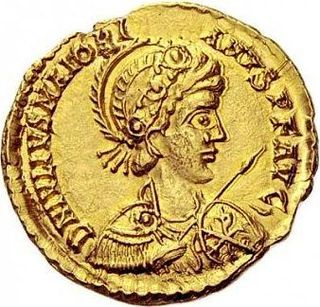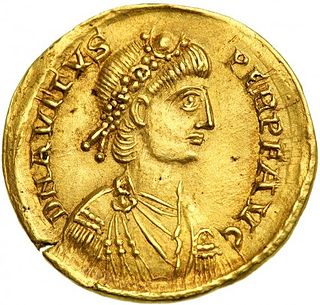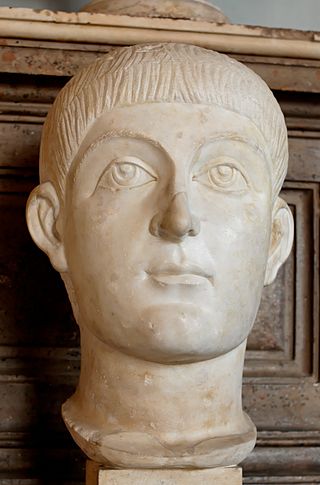
The Burgundians were an early Germanic tribe or group of tribes. They appeared in the middle Rhine region, near the Roman Empire, and were later moved into the empire, in eastern Gaul. They were possibly mentioned much earlier in the time of the Roman Empire as living in part of the region of Germania that is now part of Poland.
The 450s decade ran from January 1, 450, to December 31, 459.
The 460s decade ran from January 1, 460, to December 31, 469.

Year 461 (CDLXI) was a common year starting on Sunday of the Julian calendar. At the time, it was known as the Year of the Consulship of Severinus and Dagalaiphus. The denomination 461 for this year has been used since the early medieval period, when the Anno Domini calendar era became the prevalent method in Europe for naming years.

Julius Nepos, or simply Nepos, ruled as Roman emperor of the West from 24 June 474 to 28 August 475. After losing power in Italy, Nepos retreated to his home province of Dalmatia, from which he continued to claim the western imperial title, with recognition from the Eastern Roman Empire, until he was murdered in 480. Though Nepos' successor in Italy, Romulus Augustulus, is traditionally deemed the last western Roman emperor, Nepos is regarded by some historians as the true last emperor of the west, being the last widely recognised claimant to the position.

Ricimer was a Romanized Germanic general who effectively ruled the remaining territory of the Western Roman Empire from 456 after defeating Avitus, until his death in 472, with a brief interlude in which he contested power with Anthemius. Deriving his power from his position as magister militum of the Western Empire, Ricimer exercised political control through a series of puppet emperors. Ricimer's death led to unrest across Italy and the establishment of a Germanic kingdom on the Italian Peninsula.

Majorian, was the Western Roman emperor from 457 to 461. A prominent commander in the Western military, Majorian deposed Avitus in 457 with the aid of his ally Ricimer. Possessing little more than Italy, Dalmatia, as well as some territory in Hispania and northern Gaul, Majorian campaigned rigorously for three years against the Empire's enemies. In 461, he was murdered at Dertona in a conspiracy, and his successors until the Fall of the Empire in 476 were puppets either of barbarian generals or the Eastern Roman court.

Procopius Anthemius was the Western Roman emperor from 467 to 472. Born in the Eastern Roman Empire, Anthemius quickly worked his way up the ranks. He married into the Theodosian dynasty through Marcia Euphemia, daughter of Eastern emperor Marcian. He soon received a significant number of promotions to various posts, and was presumed to be Marcian's planned successor. However, Marcian's sudden death in 457, together with that of Western emperor Avitus, left the imperial succession in the hands of Aspar, who instead appointed a low-ranking officer known as Leo to the Eastern throne out of fear that Anthemius would be too independent. Eventually, this same Leo would designate Anthemius as Western emperor in 467, following a two-year interregnum that started in 465.

Eparchius Avitus was Roman emperor of the West from July 455 to October 456. He was a senator of Gallic extraction and a high-ranking officer both in the civil and military administration, as well as Bishop of Piacenza.

Gaius Sollius Modestus Apollinaris Sidonius, better known as Sidonius Apollinaris, was a poet, diplomat, and bishop. Born into the Gallo-Roman aristocracy, he was son-in-law to Emperor Avitus and was appointed Urban prefect of Rome by Emperor Anthemius in 468. In 469 he was appointed Bishop of Clermont and he led the defence of the city from Euric, King of the Visigoths, from 473 to 475. He retained his position as bishop after the city's conquest, until his death in the 480s. He is venerated as a saint in the Catholic church, the Orthodox Church, and the True Orthodox Church, with his feast day on 21 August.
Aegidius was the ruler of the short-lived Kingdom of Soissons from 461 to 464/465. Before his ascension he was an ardent supporter of the Western Roman emperor Majorian, who appointed him magister militum per Gallias in 458. After the general Ricimer assassinated Majorian and replaced him with Emperor Libius Severus, Aegidius rebelled and began governing his Gallic territory as an independent kingdom. He may have pledged his allegiance to the Eastern Roman emperor Leo I.

The term Last of the Romans has historically been used to describe a person thought to embody the values of ancient Roman civilization – values which, by implication, became extinct on his death. It has been used to describe a number of individuals. The first recorded instance was Julius Caesar's description of Marcus Junius Brutus as the one with whom the old Roman spirit would become extinct.

The Kingdom or Domain of Soissons is the historiographical name for the ethnically Roman, de facto independent remnant of the Western Roman Empire's Diocese of Gaul, which existed during Late Antiquity as an initially nominal enclave and later rump state of the Empire until its conquest by the Franks in AD 486. Its capital was at Noviodunum, today the town of Soissons in France. The rulers of the rump state, notably its final ruler Syagrius, were referred to as "kings of the Romans" by the Germanic peoples surrounding Soissons, with the polity itself being identified as the Regnum Romanorum, "Kingdom of the Romans", by the Gallo-Roman historian Gregory of Tours. Whether the title of king was used by Syagrius himself or was applied to him by the barbarians surrounding his realm is unknown.
Placidia was a daughter of Valentinian III, Roman emperor of the West from 425 to 455, and from 454/455 the wife of Olybrius, who became western Roman emperor in 472. She was one of the last imperial spouses in the Roman west, during the Fall of the Western Roman Empire during Late Antiquity.

Marcellinus was a Roman general and patrician who ruled over the region of Dalmatia in the Western Roman Empire and held sway with the army there from 454 until his death.

Libius Severus, sometimes enumerated as Severus III, was emperor of the Western Roman Empire from 461 to his death in 465. A native of Lucania, Severus was the fourth of the so-called Shadow Emperors who followed the deposition of the Valentinianic dynasty in 455. He ruled for just under four years, attaining the throne after his predecessor, Majorian, was overthrown by his magister militum, Ricimer. Severus was the first of a series of emperors who were highly dependent on the general, and it is often presumed that Ricimer held most of the de facto power during Severus' reign
Caecina Decius Basilius was a politician of the Western Roman Empire, Consul and twice Praetorian prefect of Italy.
Agrippinus was a general of the Western Roman Empire, Magister militum per Gallias under emperors Valentinian III, Petronius Maximus, Avitus and Libius Severus.
Nepotianus was a general of the Western Roman Empire.
Sunieric was a Visigoth general, who collaborated with the Roman army in the re-conquest of Spain on behalf of Emperor Majorian.